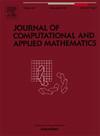带坡度选择的二维时间分数分子束外延模型的多重保动力分裂混合有限元方法
IF 2.6
2区 数学
Q1 MATHEMATICS, APPLIED
Journal of Computational and Applied Mathematics
Pub Date : 2025-10-01
DOI:10.1016/j.cam.2025.117137
引用次数: 0
摘要
本文研究了带坡度选择的二维时间分数分子束外延模型的一种新的数值方法及其离散动力学分析。提出了一种多重保动力分裂混合有限元法求解该模型。给出了该方法唯一的可解性判据。在没有步长约束的情况下,证明了该方法在离散意义上是保持能量稳定、保持变分能量耗散规律和保持l2范数稳定的。此外,在适当的条件下,给出了该方法的误差估计,表明该方法可以达到2−α (resp)阶的收敛。M +1)在时间上。在空间中),其中α和m+1分别表示模型中分数阶导数的阶数和所使用的有限元空间的维数。通过一系列数值实验,进一步验证了该方法的误差估计和离散动力学特性。本文章由计算机程序翻译,如有差异,请以英文原文为准。
A multiple-dynamics-preserving splitting mixed finite element method for 2D time-fractional molecular beam epitaxy model with slope selection
This paper deals with a new numerical method and its discrete dynamical analysis for 2D time-fractional molecular beam epitaxy model with slope selection. A multiple-dynamics-preserving splitting mixed finite element method is proposed to solve the model. A unique solvability criterion of the method is given. Under no stepsize constraint, the method is proved to be energy-stability-preserving, variational-energy-dissipation-law-preserving and -norm-stability-preserving in the discrete sense. Moreover, an error estimate of the method is derived under the suitable condition, which shows that the method can arrive at convergence order (resp. ) in time (resp. in space), where and denote the order of fractional derivatives in the model and the dimension of the used finite element space, respectively. By performing a series of numerical experiments, the error estimate and discrete dynamical properties of the method are further confirmed.
求助全文
通过发布文献求助,成功后即可免费获取论文全文。
去求助
来源期刊
CiteScore
5.40
自引率
4.20%
发文量
437
审稿时长
3.0 months
期刊介绍:
The Journal of Computational and Applied Mathematics publishes original papers of high scientific value in all areas of computational and applied mathematics. The main interest of the Journal is in papers that describe and analyze new computational techniques for solving scientific or engineering problems. Also the improved analysis, including the effectiveness and applicability, of existing methods and algorithms is of importance. The computational efficiency (e.g. the convergence, stability, accuracy, ...) should be proved and illustrated by nontrivial numerical examples. Papers describing only variants of existing methods, without adding significant new computational properties are not of interest.
The audience consists of: applied mathematicians, numerical analysts, computational scientists and engineers.

 求助内容:
求助内容: 应助结果提醒方式:
应助结果提醒方式:


